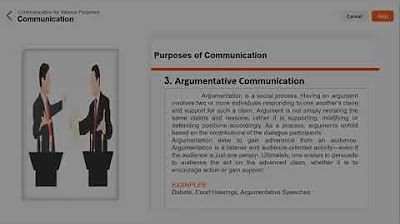Prepared-Impromptu Speech |PUBLIC SPEAKING |GRADE 10|| MELC-based VIDEO LESSON | QUARTER 2| MODULE 6
Summary
TLDRThis video tutorial focuses on the essentials of public speaking, highlighting techniques for delivering both prepared and impromptu speeches. It covers the purpose of public speaking, knowing your audience, using non-verbal cues, staying calm, and speaking with clarity. The video also emphasizes preparation, practice, and using visual aids to enhance presentations. It provides practical tips to boost confidence and improve speaking skills, helping viewers become better public speakers. The video ends with a reminder to embrace feedback and continuously refine public speaking abilities.
Takeaways
- 🕒 **Time Check**: The video emphasizes the importance of timing and preparation in public speaking.
- 🎤 **Speak with Ease**: The video aims to make English public speaking easy through various techniques.
- 📢 **Public Speaking Defined**: Public speaking is defined as conveying purposeful information to inform, influence, or entertain an audience.
- 🎓 **Types of Speeches**: The script distinguishes between prepared speeches, which allow for research and rehearsal, and impromptu speeches, which require speaking without preparation.
- 👤 **Audience Engagement**: Knowing your audience is crucial for planning content, language, and delivery style.
- 🔍 **Research**: Thorough research is advised to ensure confidence and credibility in the information presented.
- 👀 **Non-Verbal Cues**: Effective use of gestures and eye contact helps convey ideas and maintain audience connection.
- 🧘 **Stay Calm**: Maintaining composure and avoiding signs of nervousness is key to successful public speaking.
- 📚 **Practice**: Regular practice is essential for improving public speaking skills.
- 📈 **Visual Aids**: When used appropriately, visual aids can support the speech but should not overshadow the speaker.
- 👔 **Dress Appropriately**: Dressing comfortably yet formally can boost confidence and convey respect to the audience.
- 💬 **Open to Feedback**: Being open to questions and comments is important for continuous improvement as a speaker.
Q & A
What is the main purpose of the video?
-The main purpose of the video is to teach techniques in public speaking and help learners improve their ability to deliver prepared or impromptu speeches.
What are the two common types of speeches mentioned in the video?
-The two common types of speeches mentioned are prepared speeches and impromptu speeches.
What is the key difference between a prepared speech and an impromptu speech?
-In a prepared speech, the speaker has time to research and rehearse before delivering the speech, while in an impromptu speech, the speaker is given little or no time to prepare.
What is an extemporaneous speech?
-An extemporaneous speech is a type of prepared speech where the speaker is given some time to prepare before delivering the speech but may still rely on notes or a prepared copy for reference.
Why is knowing the purpose of your speech important?
-Knowing the purpose of your speech helps focus your discussion and allows you to stay on track with your goal, whether it is to inform, persuade, or inspire the audience.
What techniques are recommended for becoming a better public speaker?
-The video recommends several techniques, including knowing your purpose, being familiar with your topic, knowing your audience, planning ahead, using non-verbal cues, staying calm, practicing, and speaking with clarity.
What should a speaker consider when addressing different types of audiences?
-A speaker should adjust their content, language, and techniques based on the audience. For example, a speech to high school students would differ from one delivered to professionals.
How can a speaker use non-verbal cues effectively?
-Non-verbal cues like gestures, eye contact, and body movements help convey ideas more clearly, but they should be used in moderation to avoid distracting the audience.
Why is practice important for public speaking?
-Practice helps identify areas for improvement and build confidence. Consistent practice is necessary to become a compelling speaker.
What are some common mistakes to avoid in public speaking?
-Common mistakes include cramming, overusing gestures, showing signs of nervousness, and not being clear in pronunciation or pacing. These can negatively affect the speech's effectiveness.
Outlines

Esta sección está disponible solo para usuarios con suscripción. Por favor, mejora tu plan para acceder a esta parte.
Mejorar ahoraMindmap

Esta sección está disponible solo para usuarios con suscripción. Por favor, mejora tu plan para acceder a esta parte.
Mejorar ahoraKeywords

Esta sección está disponible solo para usuarios con suscripción. Por favor, mejora tu plan para acceder a esta parte.
Mejorar ahoraHighlights

Esta sección está disponible solo para usuarios con suscripción. Por favor, mejora tu plan para acceder a esta parte.
Mejorar ahoraTranscripts

Esta sección está disponible solo para usuarios con suscripción. Por favor, mejora tu plan para acceder a esta parte.
Mejorar ahoraVer Más Videos Relacionados

BAHASA SUNDA - PPT BIANTARA KELAS 9 BAB 1 (LAWUNGAN KA-2)

TEACHING DEMONSTRATION IN ENGLISH 10 PUBLIC SPEAKING (COLLEGE BEST DEMONSTRATOR IN ENGLISH 2021)

Extemporaneous vs Impromptu Speech Delivery and When To Use Them

Materi Pidato ( Pengertian, Tujuan, Struktur, Jenis, dan Metode Pidato ) #materipidato

PURPOSIVE COMMUNICATION CHAPTER 6: COMMUNICATION FOR VARIOUS PURPOSES

Types of speech according to delivery| Impromptu & Extemporaneous Speeches | Oral Communication
5.0 / 5 (0 votes)
